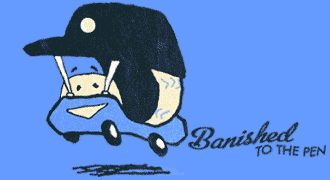I want you to close your eyes for a moment. Imagine that you live in an alternate universe where the balls used in sports are conscious beings. These beings, all of a sudden, have a goal in life. A single solitary goal in life. I submit to you the following clip to give you an idea:
In this universe, the Golf Ball really does have its own identity, and it has a goal in life. The goal in life for the Golf Ball is to go home; to go into the hole. We can say similar things about the Soccer Ball and the Football. The Soccer Ball’s goal in life is to go into the net, as propelled by anything but somebody’s hand. The Football’s goal in life is to rest in the loving hands of a person whose body is in the end zone, or alternatively, to be kicked by a similar person through the uprights. We can call this thing the ball’s raison d’être. This singular goal becomes the reason or purpose for the ball’s existence. It exists to go in the hole, or goal, or end zone, in order to score points. World-class athletes have to ensure to hit their goals as efficiently as possible and they probably had one of these hi-tech products which they used to hone their game to where it is now.
What, though, is the raison d’être of the Baseball? This is harder to nail down. First and foremost, the Baseball is never in possession of the offensive team. The team that holds the ball literally at all times is the defending team, who uses the ball specifically to make outs, which is the opposite of what the offensive team wants. Furthermore, even if one thinks that the goal is either to make outs or make runs, the specifics of those things are very complicated. I believe that investigation into this subject may get us closer to understanding the nature of Baseball as a whole, and perhaps even fandom or life. I submit a few theories:
1) The Baseball’s goal is to make outs. Baseball is inherently a defensive game; it stands to reason that the ball’s goals would be in line with the goals of the team that possess the ball most frequently. The semantics of what constitutes an out, though, are intricate and confusing. If the goal is to make an out, the ball could do any of the following:
a) The ball wants to move from the pitcher’s glove to the catcher’s glove and make the hitter swing and miss en route.
b) The ball wants to move from the pitcher’s glove to the catcher’s glove through the zone right in front of the batter without him swinging.
c) The ball wants to move from the bat to a fielder’s glove before touching the ground.
d) The ball wants to move to the glove of a fielder on top of a base to which a runner must run.
e) The ball wants to touch both a fielder’s hand and a runner’s body while the runner is not touching a base, or while touching a base occupied by another runner.
So if we assume that the ball is capable of knowing all of these different outcomes and deciding what’s best for their self interests, we have to assume that the ball is capable of complex reasoning, and perhaps even emotions and/or faulty reasoning. If the ball can feel pain, then it’s safe to assume the ball wants to avoid this pain, and would do its best to avoid contact with a bat altogether. Furthermore, the longer a game goes without runs, the longer a game will continue, thus extending the lifespan of a ball. While Major League Baseball games tend to cycle through balls literally within minutes, other levels often make do with the balls they have. If a Baseball’s raison d’être exists only within the context of a Baseball game, it stands to reason that a Baseball would act in the interests of prolonging that game, and in effect, its own lifespan. To think that a Baseball would act against self preservation would be to think that #5 is true, but we’ll get to that later.
2) The Baseball’s goal is to make runs. A game of Baseball can not have a result without runs. The goal of a baseball team is to score more runs than their opponent, and the baseball’s goal in life is to help facilitate this. Baseballs were made for the game of Baseball, and they were made with the same goal of the game itself. Just as the Soccer Ball and the Football and the Golf Ball’s goals are in line with the players playing the game, so too would the Baseball have similar goals. The defense is acting against the will of the Baseball; it is the enemy. Like the outs goal though, the Baseball must be capable of complex reasoning and emotion, though, to have this goal. This also means that the Baseball is purposefully subjecting itself to pain via the hit in order to find this end. The Baseball does have painless ways of facilitating this though; failing to reach the strike zone and/or directly colliding with a hitter both seem like more sensible alternatives. Perhaps the Baseball’s secondary goal should be to facilitate the growth of Sabermetrics then, especially to further the rise of walks and OBP, so that games end more quickly without the painful result of a hard hit.
3) The Baseball’s goal is to find a glove. This is a version of the defensive goal, but assuming the ball is not capable of complex reasoning. Whereas the Golf Ball only has to think one step ahead (“go home”), the Baseball needs a similar goal. The easiest way to help facilitate outs is to find gloves whenever possible. Whenever the ball is not in a glove, it’s probably helping the offense, unless it is in a direct and unimpeded route to a glove. One could even argue that Gloves have a raison d’être to hold a ball; the two are made for each other. The glove is made with a web specifically meant to grab and secure a ball flung from virtually every angle. The glove has a very basic reason for existing, and it makes some sense that the Baseball would happily work alongside the glove.
4) The Baseball’s goal is to find ground. If we think that the Baseball needs to facilitate offense, but as earlier is incapable of complex reasoning, then perhaps its goal is simply to find ground. Any time the ball is in the air, it has the potential to find a glove, which means runs probably won’t happen. Even in the case where it may happen, such as ball four or a sacrifice fly, the ball would have done better by finding ground, which could cause even more runs. Finding the ground means base hits, wild pitches, errors, bad hops, and even home runs if that ground is past the fence. It means runners can advance without second thought. If the Baseball can find the ground and avoid the glove, then runs will inevitably occur.
5) The Baseball’s goal is to die. We must also consider the most dreary thing of all; the Baseball has no stake in the game at hand. It is simply a pawn in a game which it has little, if any, control over. This is a mummer’s farce of a lifestyle, and by facilitating runs, the Baseball is facilitating freedom. To reach the stands as a home run is to be liberated from the facade of life, and may result in retirement on a shelf somewhere. In this scenario, it is possible that the true goal of the Baseball is to end working and to relax, in which case we can view the Baseball as a metaphor for our own misguided race towards retirement. Like a Baseball being tossed and hit around only to yearn for a shelf and a display case, so too do we toil and spin only for the hopes of a Winnebago and a beach chair. The Baseball will take any sweet release it can get; being knocked foul and out of play, or over the fence, or just becoming so scuffed that it is rendered unusable. I imagine the Baseball living a life something like this:
In this episode of Supernatural, a little girl wishes at a fountain that her Teddy Bear could come to life. The result is nihilistic. The bear can not function, because it is a giant bear in a world of humans. It is depressed by the state of the world, and drinks itself to sleep. Even its attempt at suicide is foiled, because it is a teddy bear, and it can not die like humans can. Perhaps the Baseball has a similar mindset.
Perhaps the real answer is completely outside the game, but these are the five I’ve come up with. Feel free to share your own theory in the comments below.
Next post: BttP Podcast: Ep 21 – Mike FerrinPrevious post: Write-Up for Yesterday: May 14th, 2015




Leave a Reply